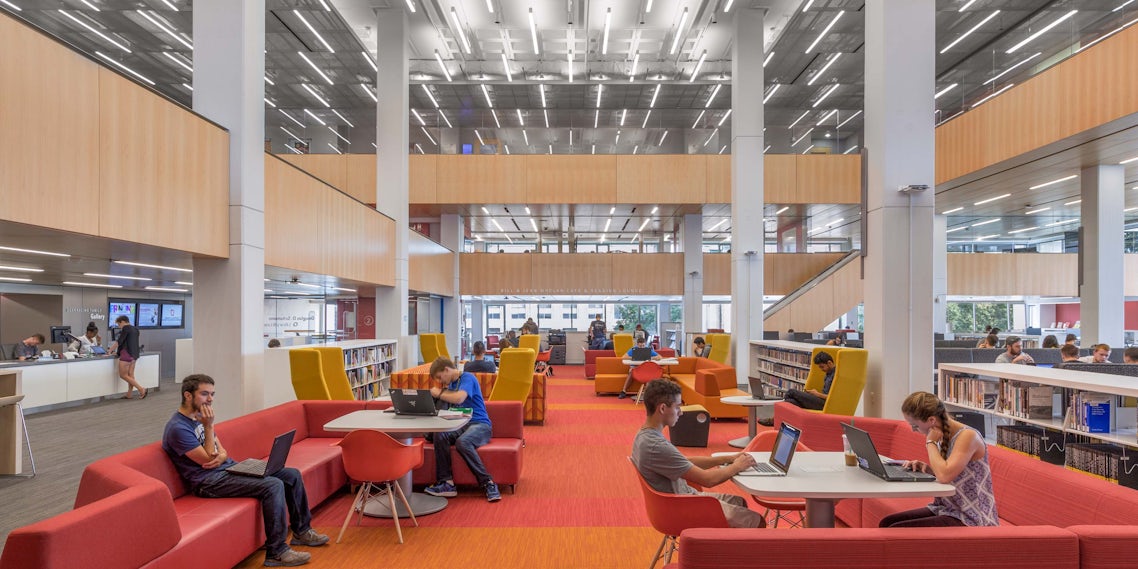This week, we sat down with Willem Boning, Acoustics Consultant at Arup’s New York City SoundLab, to uncover the complex relationship between architecture and acoustical treatments. The lesson: Architects must rethink the way that they approach acoustics.
Rather than selecting an acoustical treatment for its finish, architects must broadly and conceptually think about how they want a space to sound and feel. “What excites the Arup SoundLab is to be able to work with an architect or owner to design the sound of a space, not just make it quiet or prevent problems,” Boning said. Should it buzz with excitement or induce serenity so that individuals may independently and quietly work? Seek to tell a narrative with your sound; that’s when Arup’s acousticians can really step in and help.

Inside New York City’s SoundLab; image via The Architect’s Newspaper
The SoundLab was created to help clients make immersive decisions about how much sound-absorbing treatment they should use in a project. Their driving philosophy: The best way to make that decision is “to listen and trust one’s own ears.” Instead of presenting a client with abstract graphs or numbers and exhorting “believe us, a 1.2-second reverberation time will work best here,” the innovative approach immerses clients in the potential sound conditions of a future architectural environment.
It is a container for the real or modeled sound of an alternate place.

The Arup SoundLab helps clients make more informed acoustic decisions by immersing them in the sounds of their prospective designs; image via Metropolis.
To create a precise simulative environment, the New York City SoundLab harnesses two common yet distinct avenues of acoustic treatment: isolation and absorption. All external noise must be blocked out or “isolated” so that the only sound heard is being played from the speakers inside. Not only is the ceiling designed to block footsteps from above, but the room is built up on a structurally isolated floor, blocking out vibrations from the subway below. While the walls are completely coated in 4 inches of sound-absorbing, rigid duct liner, the wooden floor is only partially covered. As a result, the room’s reverberation time is very short yet just present enough “to prevent you from going crazy.”
So how does this help architects? Using Ambisonics, an open-source technology, and a process called convolution, the SoundLab allows clients to hear how varying levels of acoustical treatment will affect their final design. To demonstrate this, the acousticians encode a dry anechoic signal with the properties and reverberations of a real room or modeled room. “Anything you listen to in the lab is as if you’re listening in a much larger space. That said, it is still difficult to get a sense of scale and grandeur, which is why we are beginning to work with VR.”


At Museo del Acero by Grimshaw Architects, the client worked with Arup’s SoundLab to bring acoustical treatment to the forefront of their design; images via Grimshaw Architects.
Located in Monterrey, Mexico, Museo del Acero by Grimshaw Architects is one project where sound-absorbing treatment functioned as a focal point of the design. Made out of a former steel plant, the previously echoey space featured extensive hard surfaces such as gypsum board, metal, concrete and glass, only providing space for sound treatment inside the building’s central oculus, yet the client hoped to use the space to host conferences and banquets. By modeling four intensities of sound-absorbing treatment and convolving each with speech, jazz music and techno, the SoundLab led clients to make informed and involved decisions for creating a cost-effective and comfortable event space.
The SoundLab’s work represents a seminal precedent within a crucial yet unexplored arena of architectural acoustics. The lab guides clients in diving much deeper than viewing acoustic treatment as a material mask to unkind noise. Instead, acoustic conditions are dynamic and possess feedback effects, which ultimately loop back into how people conduct themselves in a particular space: Upon entry, will you speak up or naturally quiet down? And as adaptive reuse becomes increasingly prominent among offices and co-working spaces, this research will prove indispensable.

Despite breaking all the traditional rules of acoustics, New York City’s Grand Central Terminal rings with a pleasant buzz throughout the day; image via Huffington Post.
For Boning, “New York City’s Grand Central Station is a benchmark for a unique soundscape with a pleasant quality.” Offering cues for future open-plan office design, Grand Central is populated, reverberant and filled with conversation yet remarkably easy to focus in. “You don’t feel like you need to raise your voice” or chime in on any single piece of intelligible speech. At any time of day, you are simply met by a comfortable level of ambient noise. The SoundLab is currently well underway with highly calibrated research that seeks to replicate the qualities of this environment.
While acoustic treatments are typically marketed as “quieter is always better,” there are no standards or regulations for creating optimal acoustic conditions. Today, it remains a field of experimentation. Sometimes, applying acoustic treatment may feel like tuning an instrument without knowing exactly what key you are seeking to arrive at.
One of the SoundLab’s end goals is to design a precisely calculated approach; knowing how much of a wall to make sound-absorbing should be like knowing how to build a façade that blocks out the rain. That equilibrium will inevitably lie somewhere in between “something is better than nothing” and “sometimes, less is more.” Until then, the SoundLab encourages architects to think conceptually and as early on in the design stage as possible about exactly what they are trying to achieve, not just what aesthetic materials they are hoping to employ.




